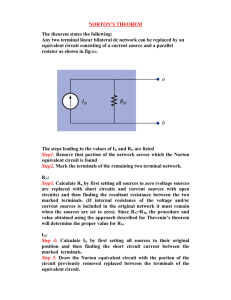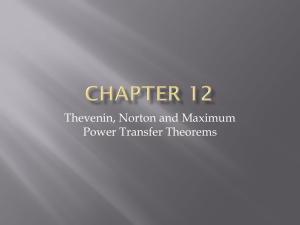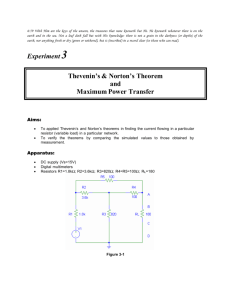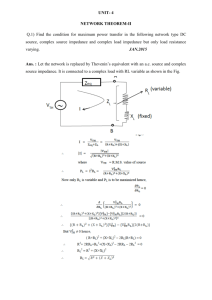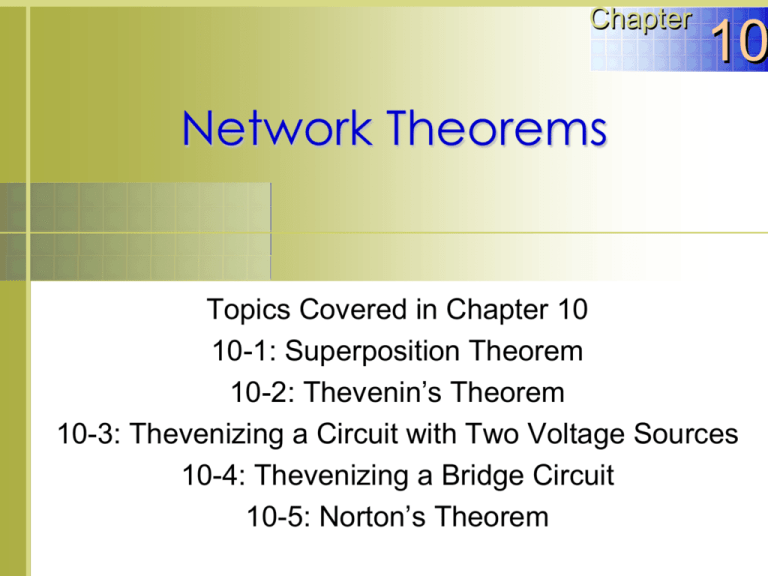
Chapter
10
Network Theorems
Topics Covered in Chapter 10
10-1: Superposition Theorem
10-2: Thevenin’s Theorem
10-3: Thevenizing a Circuit with Two Voltage Sources
10-4: Thevenizing a Bridge Circuit
10-5: Norton’s Theorem
Topics Covered in Chapter 10
10-6: Thevenin-Norton Conversions
10-7: Conversion of Voltage and Current Sources
10-8: Millman’s Theorem
10-9: T or Y and π or Δ Conversions
McGraw-Hill
© 2007 The McGraw-Hill Companies, Inc. All rights reserved.
10-1: Superposition Theorem
The superposition theorem extends the use of Ohm’s
Law to circuits with multiple sources.
In order to apply the superposition theorem to a
network, certain conditions must be met:
1. All the components must be linear, meaning that
the current is proportional to the applied voltage.
10-1: Superposition Theorem
2. All the components must be bilateral, meaning that
the current is the same amount for opposite
polarities of the source voltage.
3. Passive components may be used. These are
components such as resistors, capacitors, and
inductors, that do not amplify or rectify.
4. Active components may not be used. Active
components include transistors, semiconductor
diodes, and electron tubes. Such components are
never bilateral and seldom linear.
10-1: Superposition Theorem
In a linear, bilateral network that has more than one
source, the current or voltage in any part of the network
can be found by adding algebraically the effect of each
source separately.
This analysis is done by:
shorting each voltage source in turn.
opening each current source in turn.
10-1: Superposition Theorem
Fig. 10-1: Superposition theorem applied to a voltage divider with two sources V1 and V2. (a)
Actual circuit with +13 V from point P to chassis ground. (b) V1 alone producing +16 V at P. (c)
V2 alone producing −3 V at P.
Copyright © The McGraw-Hill Companies, Inc. Permission required for reproduction or display.
10-1: Superposition Theorem
R2
R1
15 V
V1
100 Ω
10 Ω
20 Ω
R3
R2
R1
15 V
V1
100 Ω
10 Ω
13 V
V2
20 Ω
R3
V2 shorted
REQ = 106.7 Ω, IT = 0.141 A and IR3 = 0.094 A
10-1: Superposition Theorem (Applied)
15 V
V1
V1 shorted
R1
R2
100 Ω
20 Ω
10 Ω
R3
R1
R2
100 Ω
20 Ω
10 Ω
R3
13 V
V2
13 V
V2
REQ = 29.09 Ω, IT = 0.447 A and IR3 = 0.406 A
10-1: Superposition Theorem (Applied)
15 V
V1
R1
R2
100 Ω
20 Ω
13 V
V2
0.094 A 0.406 A
With V2 shorted
REQ = 106.7 Ω, IT = 0.141 A and IR3 = 0.094 A
With V1 shorted
REQ = 29.09 Ω, IT = 0.447 A and IR3 = 0.406 A
Adding the currents gives IR3 = 0.5 A
10-1: Superposition Method (Check)
15 V
V1
R1
R2
100 Ω
20 Ω
10 Ω
R3
0.5 A
13 V
V2
With 0.5 A flowing in R3, the voltage across R3 must
be 5 V (Ohm’s Law). The voltage across R1 must
therefore be 10 volts (KVL) and the voltage across R2
must be 8 volts (KVL). Solving for the currents in R1
and R2 will verify that the solution agrees with KCL.
IR1 = 0.1 A and I R2 = 0.4 A
IR3 = 0.1 A + 0.4 A = 0.5 A
10-2: Thevenin’s Theorem
Thevenin’s theorem simplifies the process of solving for
the unknown values of voltage and current in a network
by reducing the network to an equivalent series circuit
connected to any pair of network terminals.
Any network with two open terminals can be replaced
by a single voltage source (VTH) and a series
resistance (RTH) connected to the open terminals. A
component can be removed to produce the open
terminals.
10-2: Thevenin’s Theorem
Fig. 10-3: Application of Thevenin’s theorem. (a) Actual circuit with terminals A and B across
RL. (b) Disconnect RL to find that VAB is 24V. (c) Short-circuit V to find that RAB is 2Ω.
Copyright © The McGraw-Hill Companies, Inc. Permission required for reproduction or display.
10-2: Thevenin’s Theorem
Fig. 10-3 (d) Thevenin equivalent circuit. (e) Reconnect RL at terminals A and B to find that VL is
12V.
Copyright © The McGraw-Hill Companies, Inc. Permission required for reproduction or display.
10-2: Thevenin’s Theorem
Determining Thevenin Resistance and Voltage
RTH is determined by shorting the voltage source and
calculating the circuit’s total resistance as seen from
open terminals A and B.
VTH is determined by calculating the voltage between
open terminals A and B.
10-2: Thevenin’s Theorem
Note that R3 does not change the value of VAB
produced by the source V, but R3 does increase
the value of RTH.
Fig. 10-4: Thevenizing the circuit of Fig. 10-3 but with a 4-Ω R3 in series with the A terminal. (a)
VAB is still 24V. (b) Now the RAB is 2 + 4 = 6 Ω. (c) Thevenin equivalent circuit.
Copyright © The McGraw-Hill Companies, Inc. Permission required for reproduction or display.
10-3: Thevenizing a Circuit
with Two Voltage Sources
The circuit in Figure 10-5 can be solved by Kirchhoff’s
laws, but Thevenin’s theorem can be used to find the
current I3 through the middle resistance R3.
Mark the terminals A and B across R3.
Disconnect R3.
To calculate VTH, find VAB across the open terminals
10-3: Thevenizing a Circuit
with Two Voltage Sources
Fig. 10-5: Thevenizing a circuit with two voltage sources V1 and V2. (a) Original circuit with
terminals A and B across the middle resistor R3. (b) Disconnect R3 to find that VAB is −33.6V. (c)
Short-circuit V1 and V2 to find that RAB is 2.4 Ω. (d) Thevenin equivalent with RL reconnected to
terminals A and B.
Copyright © The McGraw-Hill Companies, Inc. Permission required for reproduction or display.
10-4: Thevenizing a Bridge Circuit
A Wheatstone Bridge Can
Be Thevenized.
Problem: Find the voltage
drop across RL.
The bridge is unbalanced
and Thevenin’s theorem
is a good choice.
RL will be removed in this
procedure making A and
B the Thevenin terminals.
Fig. 10-6: Thevenizing a bridge circuit. (a) Original circuit with terminals A and B across middle
resistor RL.
Copyright © The McGraw-Hill Companies, Inc. Permission required for reproduction or display.
10-4: Thevenizing a Bridge Circuit
RAB = RTA + RTB = 2 + 2.4 = 4.4 Ω
VAB = −20 −(−12) = −8V
Fig. 10-6(b) Disconnect RL to find VAB of −8 V. (c) With source V short-circuited, RAB is 2 + 2.4 =
4.4 Ω.
Copyright © The McGraw-Hill Companies, Inc. Permission required for reproduction or display.
10-4: Thevenizing a Bridge Circuit
Fig. 10-6(d) Thevenin equivalent with RL reconnected to terminals A and B.
Copyright © The McGraw-Hill Companies, Inc. Permission required for reproduction or display.
10-5: Norton’s Theorem
Norton’s theorem is used to simplify a network in terms
of currents instead of voltages.
It reduces a network to a simple parallel circuit with a
current source (comparable to a voltage source).
Norton’s theorem states that any network with two
terminals can be replaced by a single current source
and parallel resistance connected across the terminals.
The two terminals are usually labeled something
such as A and B.
The Norton current is usually labeled IN.
The Norton resistance is usually labeled RN.
10-5: Norton’s Theorem
Example of a Current Source
The symbol for a current source is a circle enclosing an
arrow that indicates the direction of current flow. The
direction must be the same as the current produced by
the polarity of the corresponding voltage source (which
produces electron flow from the negative terminal).
10-5: Norton’s Theorem
Fig. 10-7: General forms for a voltage source or current source connected to a load RL across
terminals A and B. (a) Voltage source V with series R. (b) Current source I with parallel R. (c)
Current source I with parallel conductance G.
Copyright © The McGraw-Hill Companies, Inc. Permission required for reproduction or display.
10-5: Norton’s Theorem
Example of a Current Source
In this example, the current I is provided constant with
its rating regardless of what may be connected across
output terminals A and B. As resistances are added, the
current divides according to the rules for parallel
branches (inversely to branch resistances but directly
with conductances).
Note that unlike voltage sources, current sources are
killed by making them open.
10-5: Norton’s Theorem
Determining Norton Current and Voltage
IN is determined by calculating the current through a
short placed across terminals A and B.
RN is determined by shorting the voltage source and
calculating the circuit’s total resistance as seen from
open terminals A and B (same procedure as for RTH).
10-5: Norton’s Theorem
A Wheatstone Bridge Can Be Nortonized.
Fig. 10-9: Same circuit as in Fig. 10-3, but solved by Norton’s theorem. (a) Original circuit. (b)
Short circuit across terminals A and B.
Copyright © The McGraw-Hill Companies, Inc. Permission required for reproduction or display.
10-5: Norton’s Theorem
The Norton Equivalent Circuit
Replace R2 with a short and determine IN.
Apply the current divider.
Apply KCL.
RN = RTH.
The current source provides 12 A total flow, regardless
of what is connected across it. With no load, all of the
current will flow in RN. When shorted, all of the current
will flow in the short.
Connect R2.
Apply the current divider.
Use Ohm’s Law.
10-5: Norton’s Theorem
Fig. 10-9(c) The short-circuit current IN is 36/3 = 12 A. (d) Open terminals A and B but shortcircuit V to find RAB is 2 Ω, the same as RTH.
Copyright © The McGraw-Hill Companies, Inc. Permission required for reproduction or display.
10-5: Norton’s Theorem
IL = IN x RN/RN + RL = 12 x 2/4 = 6 A
Fig. 10-9(e) Norton equivalent circuit. (f) RL reconnected to terminals A and B to find that IL is 6A.
Copyright © The McGraw-Hill Companies, Inc. Permission required for reproduction or display.
10-6: Thevenin-Norton Conversions
Thevenin’s theorem says that any network can be
represented by a voltage source and series
resistance.
Norton’s theorem says that the same network can be
represented by a current source and shunt resistance.
Therefore, it is possible to convert directly from a
Thevenin form to a Norton form and vice versa.
Thevenin-Norton conversions are often useful.
10-6: Thevenin-Norton Conversions
Thevenin
Norton
Fig. 10-11: Thevenin equivalent circuit in (a) corresponds to the Norton equivalent in (b).
Copyright © The McGraw-Hill Companies, Inc. Permission required for reproduction or display.
10-6: Thevenin-Norton Conversions
Fig. 10-12: Example of Thevenin-Norton conversions. (a) Original circuit, the same as in Figs.
10-3a and 10-9a. (b) Thevenin equivalent. (c) Norton equivalent.
Copyright © The McGraw-Hill Companies, Inc. Permission required for reproduction or display.
10-7: Conversion of Voltage
and Current Sources
Converting voltage and current sources can simplify
circuits, especially those with multiple sources.
Current sources are easier for parallel connections,
where currents can be added or divided.
Voltage sources are easier for series connections,
where voltages can be added or divided.
10-7: Conversion of Voltage
and Current Sources
Norton conversion is a specific example of the
general principle that any voltage source with its
series resistance can be converted to an equivalent
current source with the same resistance in parallel.
Conversion of voltage and current sources can often
simplify circuits, especially those with two or more
sources.
Current sources are easier for parallel connections,
where currents can be added or divided.
Voltage sources are easier for series connections,
where voltages can be added or divided.
10-7: Conversion of Voltage
and Current Sources
Fig. 10-14: Converting two voltage sources in V1 and V2 in
parallel branches to current sources I1 and I2 that can be
combined. (a) Original circuit. (b) V1 and V2 converted to
parallel current sources I1 and I2. (c) Equivalent circuit with
one combined current source IT.
Copyright © The McGraw-Hill Companies, Inc. Permission required for reproduction or display.
10-7: Conversion of Voltage
and Current Sources
Fig. 10-15: Converting two current sources I1 and I2 in series to voltage sources V1 and V2 that
can be combined. (a) Original circuit. (b) I1 and I2 converted to series voltage sources V1 and V2.
(c) Equivalent circuit with one combined voltage source VT.
Copyright © The McGraw-Hill Companies, Inc. Permission required for reproduction or display.
10-8: Millman’s Theorem
Millman’s theorem provides a shortcut for finding the
common voltage across any number of parallel
branches with different voltage sources.
The theorem states that the common voltage across
parallel branches with different voltage sources can be
determined by:
V1 V2 V3
+
+
R1 R 2 R 3
VXY =
etc
1 1
1
+
+
R1 R 2 R 3
This formula converts the voltage sources to current
sources and combines the results.
10-8: Millman’s Theorem
−84/12 + 0/6 − 21/3
−7 + 0 + − 7
=
1/12 + 1/6 + 1/3
7/12
−14
12
=
= − 14 ×
7/12
7
VXY = − 24 V = V3
VXY =
Fig. 10-17: The same circuit as in Fig. 9-4 for Kirchhoff’s laws, but shown with parallel branches
to calculate VXY by Millman’s theorem.
Copyright © The McGraw-Hill Companies, Inc. Permission required for reproduction or display.
10-9: T or Y and π or Δ Conversions
Circuits are sometimes called different names according
to their shapes.
This circuit is the same circuit in both diagrams. The
one on the left is a T (tee) network; the one on the right
is a Y (wye) network.
Fig. 10-19: The form of a T or Y network.
Copyright © The McGraw-Hill Companies, Inc. Permission required for reproduction or display.
10-9: T or Y and π or Δ Conversions
Both of the following networks are the same; the one on
the left is called a pi (π), and the one on the right is
called a delta (Δ), because the forms resemble those
Greek characters.
Fig. 10-20: The form of a π or Δ network.
Copyright © The McGraw-Hill Companies, Inc. Permission required for reproduction or display.
10-9: T or Y and π or Δ Conversions
The Y and Δ forms are different ways to connect three
resistors in a passive network.
When analyzing such networks, it is often useful to
convert a Δ to a Y or vice-versa.
10-9: T or Y and π or Δ Conversions
Delta-to-Wye Conversion
A delta (Δ) circuit can be converted to a wye (Y)
equivalent circuit by applying Kirchhoff’s laws:
R1 =
R BR C
RA + RB + RC
R CR A
R2 =
RA + RB + RC
R3 =
RA
R2
RC
RB
R AR B
RA + RB + RC
This approach also converts a T to a π network.
R3
R1
10-9: T or Y and π or Δ Conversions
Wye-to-delta Conversion
A wye (Y) circuit can be converted to a delta (Δ)
equivalent circuit by applying Kirchhoff’s laws:
R R + R 2R 3 + R 1R 3
RA = 1 2
R1
R R + R 2R 3 + R 1R 3
RB = 1 2
R2
R 1R 2 + R 2R 3 + R 1R 3
RC =
R3
RA
R2
R3
R1
RC
RB
10-9: T or Y and π or Δ Conversions
Useful aid in using formulas:
Place the Y inside the Δ.
Note the Δ has three closed
sides and the Y has three
open arms.
Note how resistors can be
considered opposite each
other in the two networks.
Each resistor in an open
arm has two adjacent
resistors in the closed sides.
Fig. 10-21: Conversion between Y and Δ networks.
Copyright © The McGraw-Hill Companies, Inc. Permission required for reproduction or display.
10-9: T or Y and π or Δ Conversions
In the formulas for the Y-to-Δ conversion, each side of
the delta is found by first taking all possible cross
products of the arms of the wye, using two arms at a
time. (There are three such cross products.)
The sum of the three cross products is then divided by
the opposite arm to find the value of each side of the
delta.
Note that the numerator remains the same, the sum of
the three cross products.
Each side of the delta is calculated by dividing this
sum by the opposite arm.
10-9: T or Y and π or Δ Conversions
For the Δ-to-Y conversion, each arm of the wye is
found by taking the product of the two adjacent sides
in the delta and dividing by the sum of the three sides
of the delta.
The product of the two adjacent resistors excludes the
opposite resistor.
The denominator for the sum of the three sides
remains the same in the three formulas.
Each arm is calculated by dividing the sum into each
cross product.
10-9: T or Y and π or Δ Conversions
A Wheatstone Bridge Can Be Simplified.
The total current IT from the battery is desired. Therefore, total
resistance RT must be found.
Fig. 10-22: Solving a bridge circuit by Δ-to-Y conversion. (a) Original circuit. (b) How the Y of
R1R2R3 corresponds to the Δ of RARBRC.
Copyright © The McGraw-Hill Companies, Inc. Permission required for reproduction or display.
10-9: T or Y and π or Δ Conversions
RT = R + R1 = 2.5 + 2 = 4.5 Ω
Fig. 10-22 (c) The Y substituted for the Δ network. The result is a series-parallel circuit with
the same RT as the original bridge circuit. (d) RT is 4.5Ω between points P3 and P4.
Copyright © The McGraw-Hill Companies, Inc. Permission required for reproduction or display.


